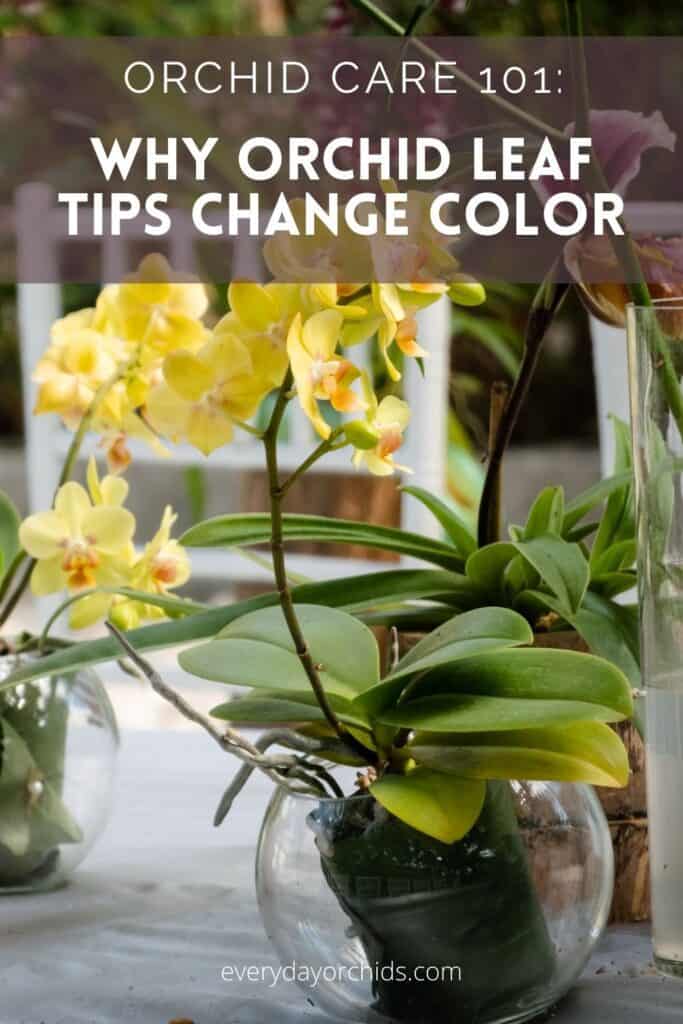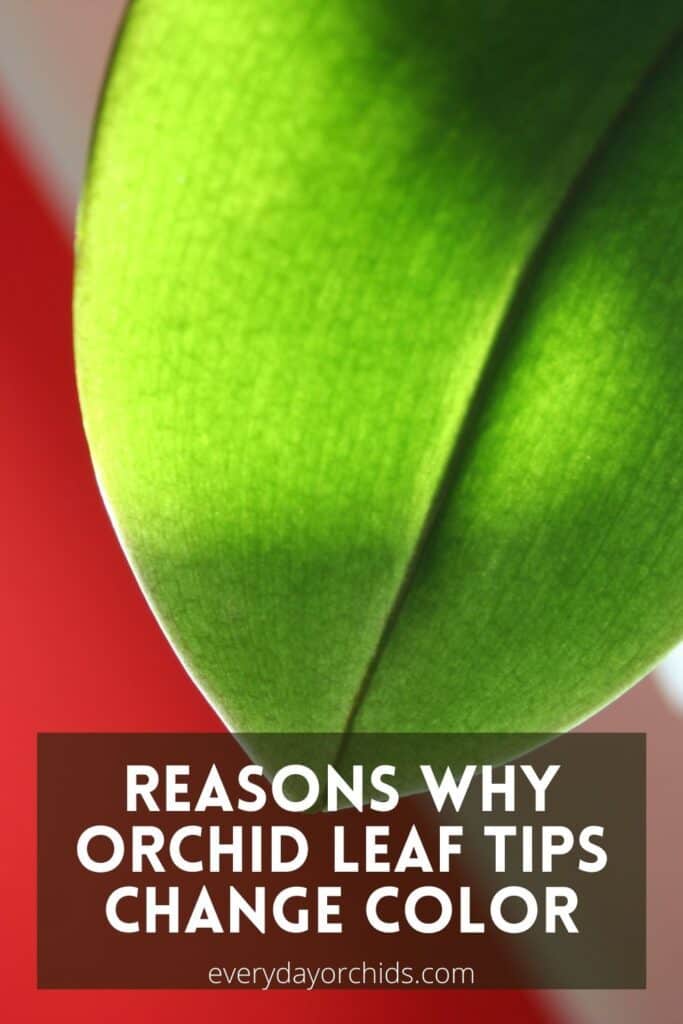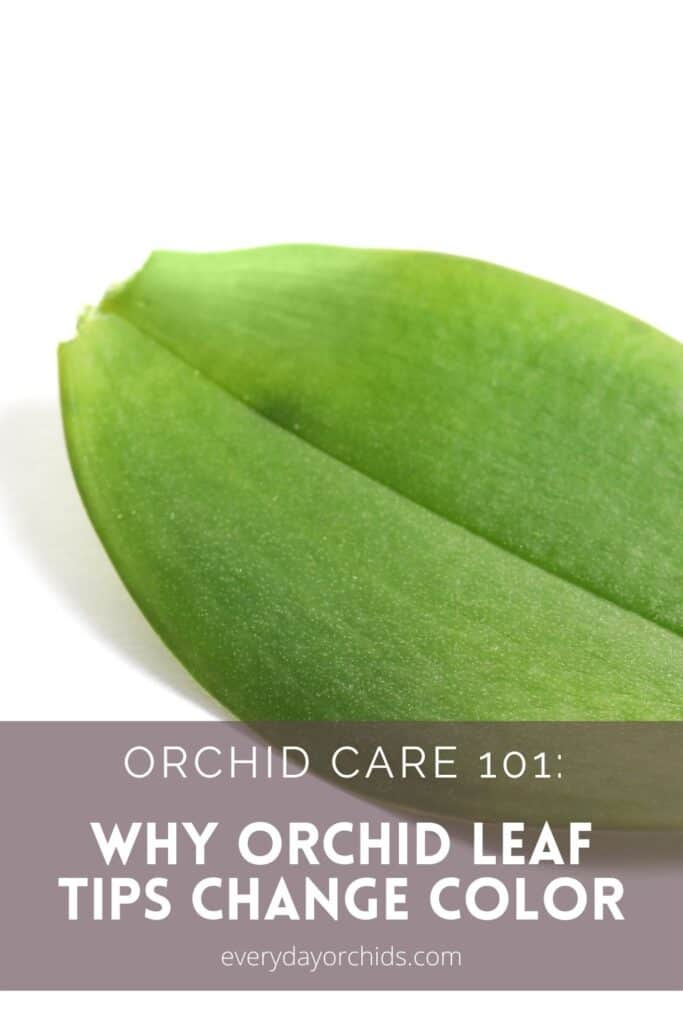If you’ve been growing orchids for any length of time, you may have noticed that your orchid’s leaf tips can change color. This is not necessarily something you can ignore. Orchid leaf tips can become brown, yellow, black, white or even purple and red for a variety of reasons and not all of them good.
A change in color in the orchid leaves indicates an underlying problem with the orchid that needs to resolved. Oftentimes, the color change will start in the orchid’s leaf tips, then continue to spread to the rest of the leaf if left untreated.
Orchid leaf tips can change color for a number of reasons, including excess fertilizer salts, dehydration, infection, and excessive sunlight exposure. Treatment depends on the cause of the problem. Treatment options include cutting off the colored tips, reducing the light exposure, and further diluting the orchid fertilizer before use.
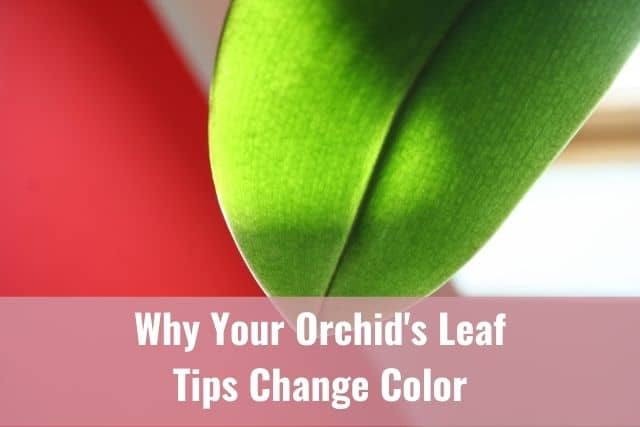
If you notice color changes in your orchid’s leaf tips, it is important to take action right away before it gets worse. I’ll go over the most common color changes you’ll see in your orchid’s leaf tips, what causes it, and what you need to do about it. Keep reading to learn more.
Please note that these links are affiliate links and as an Amazon Associate, I earn from qualifying purchases. Purchases made through affiliate links in this post may generate commissions at no additional cost to you. Use this link for a discounted Amazon Prime trial. Thank you for your support!
Table of Contents
Why Are My Orchid’s Leaf Tips Turning Yellow?
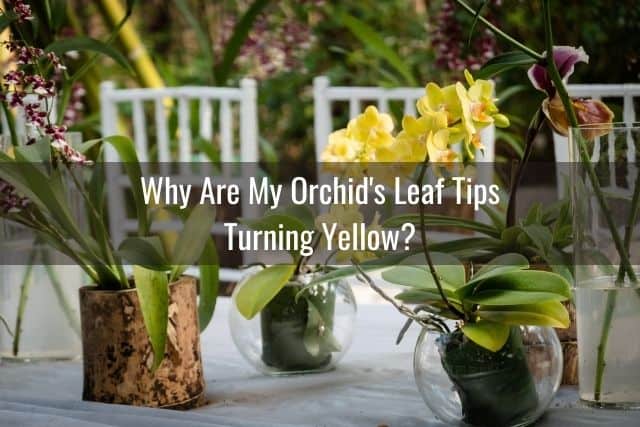
Most commonly, an orchid’s leaf tips will start to turn yellow due to over-fertilization. If left untreated, the orchid leaf tips will turn from yellow to brown, then from brown to black.
Over-watering and old age are two other reasons why an orchid’s leaf tips may start to turn yellow.
Solution For Over-Fertilization Issues
To prevent the discoloration from progressing further, you’ll need to take a step back and evaluate how you fertilize your orchids. Ask yourself the following questions:
- Are you using an orchid-specific fertilizer?
- Regular plant fertilizers may be too strong for your orchid. Always use an orchid-specific fertilizer when feeding your orchids.
- Are you fertilizing your orchids correctly?
- If you are unsure, read this guide on how to fertilize an orchid.
- Are you preparing the orchid fertilizer and then diluting it further?
- Orchids prefer weak fertilizers. Prepare the orchid fertilizer according to product instructions, then dilute it further with more water. Aim to make a 25% strength fertilizer by mixing 1 part of prepared liquid fertilizer with 3 parts of water.
- How often are you fertilizing your orchid?
- If you are using a 25% strength orchid fertilizer, you can fertilize “weakly, weekly.” However, if you are using 50% strength fertilizer, then I would recommend fertilizing only every other week or once a month.
- Are you flushing your orchid pots and potting media with plain water every 4th or 5th fertilization?
- This is important as it helps flush out any residual fertilizer salts. Doing this will also help prevent root burn from accumulated fertilizer salts.
- Are you following the fertilizer guidelines for your specific orchid?
- Different orchid species have different fertilizer needs. Read this guide to Phalaenopsis orchid care if you happen to have this popular orchid.
- Some orchids need a resting period of no fertilization during their dormant periods, while others can tolerate weak fertilization throughout the year.
- Orchids will generally need more frequent fertilization during their growth phase.
Solution For Over-Watering Problems
If your orchid’s leaf tips are turning yellow, it may be a sign of a bigger problem. Over-watering can cause the leaf tips, and eventually the whole leaf, to turn yellow.
Over-watering problems are often accompanied by other problems, such as fungus gnats, rapidly decomposing potting media, wilted orchid leaves, rotted orchid roots, and so on.
To address this issue, learn how to water your orchids the right way. Don’t water an orchid like you would with a regular house plant, several times a week.
Only water your orchid if the top few inches of potting media are dry or nearly dry. On average, orchids only need to be watered once or twice a week.
If the roots are rotted due to over-watering, you will need to cut off the rotted roots and repot your orchid. Use fresh potting media. It will take your orchid some time to recover, especially if the over-watering has been going on for a while.
As your orchid recovers, make sure it has adequate humidity. I have had good results with growing orchid roots quickly using a humidity box.
You can also use a variety of other methods to increase humidity around your orchids, including using a humidifier or humidity tray.
Yellowing of the orchid leaf tip is irreversible and it won’t become green again. However, with the right care, your orchid will be able to grow new roots and leaves. Eventually, the orchid leaves with yellowed tips will fall off on their own. I’ll go over this next.
Orchid Leaves Turning Yellow From Old Age
At times, you will notice that the tips of your orchid leaf will turn yellow. The leaf at the bottom, closest to the potting media, will be the oldest leaf on the orchid.
If the rest of your orchid is healthy and growing, and only the tips of this oldest leaf are turning yellow, then the yellowing is likely due to old age.
As an orchid leaf grows old and eventually dies, the leaf tip will turn yellow first. Over a period of several weeks, the yellow discoloration will spread to the remainder of the leaf. The leaf itself will also become withered, dried, and wrinkled. Left alone, the yellow orchid leaf will eventually die and fall off.
This is perfectly normal and not a cause for alarm.
As long as you are doing everything else right for your orchid’s care, simply remove the yellowed orchid leaf once it is dead. It will detach easily from the orchid’s main stem with a slight tug. Do not leave it on the orchid. Regular pruning and removal of dead plant tissue will go a long ways in preventing pests and disease from infesting your orchid.
Why Are My Orchid’s Leaf Tips Turning Brown?
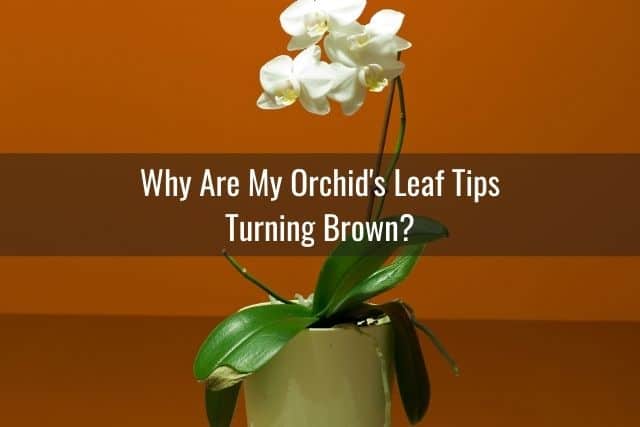
One of the reasons why an orchid’s leaf tips can turn brown is dehydration. Orchid leaf tips can also turn brown due to bacterial or fungal infections. Other reasons why orchid leaf tips turn brown include low magnesium levels, salt damage and pH levels.
Solution For Dehydration Problems
If dehydration is the reason why your orchid’s leaf tips are starting to turn brown, take a closer look at your watering practices. Read this guide on how to water your orchid to get a better idea of how and when to water an orchid.
Usually, when an orchid is very dehydrated, you will notice that the orchid leaves are limp, wrinkled, and starting to wilt. However, if just the leaf tips are starting to turn brown and the rest of the orchid leaf is still green, don’t worry. You can still save your orchid and stop the browning process.
In the summertime when the weather is warm, you may need to increase watering frequency up to two or even three times a week, depending on the condition of the potting media. Always check the potting media before watering your orchid.
If the potting media is damp and your orchid’s leaf tips are still brown, or more leaf tips are turning brown, you may have a problem with the roots.
It is possible that the roots may be rotted or dried and shriveled, and therefore, not absorbing the water. This will lead to a dehydrated orchid with brown tips.
In this case, you will need to repot your orchid and cut off the rotted and dried roots. Use fresh orchid potting media to repot your orchid.
Moving forward, pay closer attention to the watering frequency as well as humidity levels around your orchid. Low or inadequate humidity levels can also lead to dehydration in an orchid and cause brown leaf tips.
Solution For Bacterial Infection
Unfortunately, a bacterial or fungal infection can quickly turn multiple orchid leaf tips brown. The brown discoloration may not be limited to just the tips either.
The entire leaf or the center of the leaf may appear brown by the time you notice something is wrong. Oftentimes, the brown areas may feel mushy or slimy if the infection is fairly advanced.
This bacterial infection is called bacterial brown spot, or brown rot, and spreads quickly.
I have dealt with it on my own orchids before. You have to act fast or it can spread to your entire orchid. It can also infect neighboring plants, so don’t ignore this or put off treatment.
First, isolate your infected orchid. Use sterilized scissors or gardening shears to cut off all the affected leaves. Use ground cinnamon powder to seal off the cut ends of the leaves. This will work to prevent further spread of the bacteria.
If many of your orchid’s leaves have brown tips or the infection appears widespread, it would be a good idea to follow up with a fungicide treatment. You can use a fungicide product such as Physan 20 or a copper fungicide.
To prevent this from happening again, make sure you have good airflow around your orchid and manage the surrounding humidity levels.
To learn more, read this guide on bacterial brown spot and brown rot in orchids and how to treat it.
Solution To Low Magnesium Levels
Inadequate magnesium levels can cause an orchid’s leaf tips to start to turn brown and die off. You may also notice brown streaks in the middle of the leaf.
Low magnesium levels in your orchid can be easily corrected with Epsom salts. Epsom salts are inexpensive and readily available in the health and first-aid section of many drugstores.
You can read more about how to prepare an Epsom salt solution for your orchid if your orchid is struggling with low magnesium. Epsom salts are also useful in rehydrating a dehydrated orchid.
Alternatively, you can also buy an orchid fertilizer with extra magnesium. Bloom City makes a great calcium-magnesium fertilizer supplement. Just be sure to dilute this according to product directions before using on your orchids.
Solution For Salt Damage Due To Over-Fertilization
Fertilizer salts can build up in the potting media over the course of time. These salts are typically found in orchid fertilizers.
The build-up can be due to too much fertilizer use, not flushing the potting media regularly, or overly dry conditions.
As the salts accumulate, they can cause the orchid’s leaf tips to turn brown, brittle and dry up. This is the precursor to the orchid’s leaf tips turning black.
Check out the section above about orchid leaf tips turning yellow and see if you need to change anything about how you are fertilizing your orchids.
For now, flush your orchid pots and potting media thoroughly with plain water. Let the water drain out of the pot. Be sure to do this after every fourth fertilization to ensure that salts don’t start to build up again in the potting media.
Solution To pH Levels
Most of us are not aware of the pH levels in our tap water, but if your orchid’s leaf tips are turning brown and you can’t figure out why, it could be due to the pH level.
Some orchid species, such as Paphiopedilums, are more sensitive to pH levels. They will show this in browning of the leaf tips.
A high, or basic, pH level can cause the orchid’s leaf tips to start to turn brown. Lady slipper orchids and other terrestrial orchids may be more prone to this.
In general, Paphiopedilums, or Lady Slipper, orchids enjoy a lower pH, around 5. Most orchids, including Phalaenopsis orchids, will do well with a pH level between 5.5 and 6.5, which is slightly acidic.
Orchid potting media, particularly the bark, is naturally acidic, with a pH ranging from 4 to 5. The potting media will naturally bring down the pH in your orchid’s environment, more so as the potting media starts to break down.
The water, with it’s higher pH, will bring the environment’s pH up. This helps balance the acidity of the potting media. Brown tips can indicate an imbalance between the two.
You can measure your water’s pH levels easily with a home test kit. Vivosun has a digital pH meter that will allow you to test water easily and is great for hydroponic orchid growers.
You can also buy water test strips, which will test not only the pH, but also test for lead, bacteria and various minerals in the water. Both options are quick and easy to use and will give you an instant answer regarding your water’s pH levels.
Read more about orchids and pH here.
Why Are My Orchid’s Leaf Tips Turning Black?
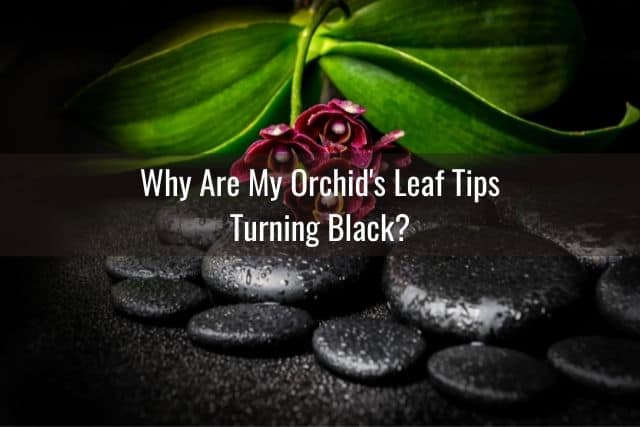
One of the top reasons why an orchid’s leaf tips may turn black is over-fertilization. This can be due to fertilizing your orchid too frequently. It may also be a result of using an orchid fertilizer that is too concentrated or not diluted enough. A calcium deficiency can also cause an orchid’s leaf tips to turn black.
Solution For Over-Fertilization
A late sign of over-fertilization is blackened, brittle orchid leaf tips. Look over the section above about yellow orchid leaf tips. If fertilization problems are not corrected early on, orchid leaf tips turn yellow, then brown, and eventually black.
Blackened orchid leaf tips will not grow back or recover. When you see these on your orchid, you will need to cut them off. When you do so, be sure you use sterilized gardening shears to prevent infections.
Solution For Calcium Deficiency
A calcium deficiency can also cause the tips of your orchid’s leaves to turn black and die off. Oftentimes, the leaf tips will curl in as well. To correct a calcium deficiency, you can do one of several things:
One, use an orchid fertilizer fortified with calcium. This orchid fertilizer by The Grow Co comes fortified with calcium and magnesium to supplement your orchid’s nutrition.
Another option is to make your own homemade orchid fertilizer out of crushed eggshells. I provide the step-by-step instructions on how to do this here in my homemade orchid fertilizer article.
Why Are My Orchid’s Leaf Tips Turning Red or Purple?
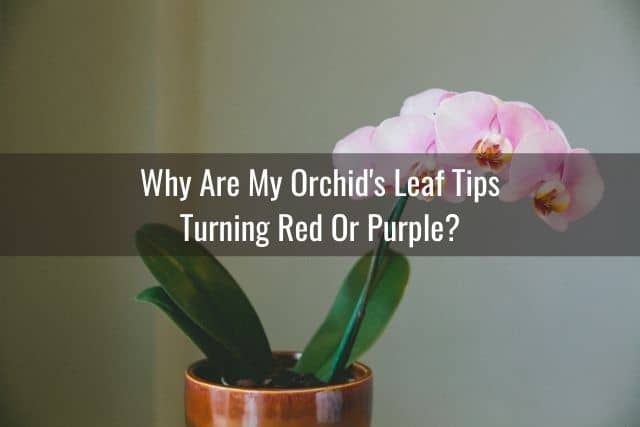
When orchid leaves turn red, this is an early sign that the orchid is receiving too much light. An early sign of sunburn in an orchid is when the edges of an orchid’s leaves turn red or purple.
Phosphorus deficiencies can also cause the edges of an orchid’s leaf to turn red. This happens in certain orchid species, not all. A classic accompanying sign of a fertilizer deficiency is curling in of the orchid’s leaf tips.
Solution For Too Much Light
If you notice your orchid’s leaf tips are turning red, adjust the lighting or location of your orchid. Do a shadow test at high noon to see how much light your orchid is receiving.
If you have a low-light orchid such as a Phalaenopsis, there is a chance that the amount of light coming in through the window is too much for this particular species.
If this is the case, move your orchid further away from the window. Alternatively, you can place a sheer curtain over the window to help block out some of the sun’s intense rays.
Once the lighting has been adjusted, the red or purple discoloration in the orchid’s leaf tips will fade away over time.
Solution For Phosphorus Deficiency
While using too much fertilizer can cause orchid leaf tips to change color, did you know that not using the right type of fertilizer can also cause the orchid’s leaf tips to turn red? This happens if the orchid is not getting enough phosphorus.
Note: This is rare and the reddish discoloration only shows up in certain orchid species, not all species.
If you notice this and your orchid’s lighting is appropriate, then try changing your orchid fertilizer.
Look for a fertilizer with a higher phosphorus level. Phosphorus ratio will be noted as the middle number in the NPK ratio.
Typically bloom booster orchid fertilizers will have a higher phosphorus level. You can try switching to this type of fertilizer for a month and see if it solves the problem.
Why Are My Orchid’s Leaf Tips Turning White?
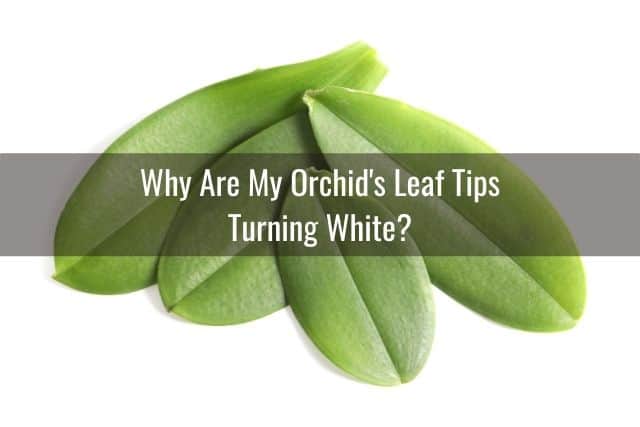
Orchid leaf tips can turn white due to sunburn. Usually, if too much light is the culprit, the orchid’s leaf tips will have turned red or purple first before they become white.
Solution For Sunburn and Excessive Light
A white orchid leaf tip has been bleached by the sun, and unfortunately, this is irreversible.
However, there are steps you can take to prevent the rest of your orchid’s leaves from turning white as well.
- Move the orchid out of direct sunlight.
- Reduce the amount of sun exposure, particularly in the afternoons, when the lighting is most intense.
- Use a thin curtain to cover the window if you decide not to move the orchid somewhere else.
Leave any white, bleached orchid leaf tips on the orchid. The rest of the green orchid leaf will still be able to perform photosynthesis. The white leaf tips may be unsightly, but they will not harm the orchid. Eventually, orchid leaves with white tips will fall off as they die of old age.
Final Thoughts
Most commonly, you’ll see orchid leaf tips turn yellow or brown. However, red, purple, black, or white orchid leaf tips are not unheard of.
If an orchid’s leaf tips start to change color, it is often an early sign to you, the orchid grower, that something needs to be adjusted regarding the orchid’s care. With the exception of yellowing due to old age, discolored orchid leaf tips are a sign of a bigger problem.
Left untreated, the discoloration in the orchid’s leaf tip will spread to the rest of the leaf. Hopefully with the help of this guide, you will have a better idea of what to do when your orchid’s leaf tip changes color. You’ll be able to deal with the problem early on and prevent it from getting worse.
As always, happy orchid growing!
If you enjoyed this article, please pin it and share!
